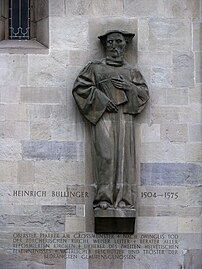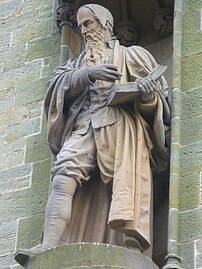Amendist Reaction
The Amendist Reaction, also known as the Amendist Reformation or the Amendist Schism, was a major schism in 1500s Sotirianity in which the pre-eminant and dominant Solarian Catholic Church was challenged by dissident religious leaders, in response to a number of percieved failings within the Church, such as Papal dynasties, indulgences, general corruption and a culture of excess. The Reaction saw the rise of Amendism as a major Sotirian denomination.
There is some debate about the exact begining of the Reaction. It is agreed to begin between 1506, when Johanne Stearn began preaching his heretical doctrine and 1514, when Stearn was excommunicated and martyred at the gates of Solaria. Prior to Stearn, there was also a number of earlier movements which attempted to amend the Church. Nevertheless, the death of Stearn after his Pilgrimage of Humility set much of the Reaction into motion, and Stearn's emergence as a martyr united the disparate amendist elements of northern Euclea, noble and lowborn alike, against the Church.
The Humble Petition and the Stearnian Bible both spread throughout the north, in part due to the invention of the printing press, which allowed for such religious materials to be quickly disseminated. A distinct Amendist Belt emerged across the north of the continent, with Estmere, Borland, Hennehouwe, Caldia, Azmara, Pergia, and much of Kirenia and Werania embracing the Reaction. Many new churches sprung up across the north, largely following a congregationalist structure. Eventually state churches emerged organised on different structures, such as the Church of Caldia and the Church of Azmara. These newly Amendist countries came into conflict with the Catholic continent, and the Amendist Wars were subsequently fought as the demand for free practice of religion was made.
To fill the void left by Stearn's death, a number of other leaders emerged, such as Hans Brúgel, Robert Welby, Johan Kasper and Seán Creag. These leaders contributed to the rise of different branches within Amendism, such as Gospelism, Kasperism and Embrianism. The exact end of the Reaction is disputed, but there is some consensus that it ended sometime following the Peace of Frankendorf, which put an end to the Amendist Wars.
Name
The events are most commonly described as the Amendist Reaction, as the movement aimed to amend the Solarian Catholic Church, in reaction to the Church's percieved failings and to the death of Johanne Stearn. Amendist Reformation is also sometimes used, in reference to the amenders' attempts to reform the church. Amendist Schism is additionally sometimes used, generally by non-Amendists.
Background

The last major split in the Sotirian Church however was the Great Schism, which saw a largely unified Sotirian Church of Solarian heritage split into what became the modern Solarian Catholic Church and the Episemialist Church. Between the Schism and the Reaction, there were a number of other attempts to challenge the Catholic Church's authority in eastern Euclea. These are sometimes described as early Amendist movements.
The Church of Caldia had already been drifting from the wider Catholic Church for centuries. The Caldish monarchs were prone to supporting antipopes, and the local clergy and church infrastructure generally followed a more matriarchal policy than the continental Church. Although the Crusade for Caldia in 1157 aimed to bring the islands back under Catholic hegemony, the Rudolphine crusaders were defeated by the Caldish defenders in 1162, which effectively solidified the de facto independence of the Caldish Church. This independence would be made official during the Reaction, with Seán Creag officially severing ties with the Papacy.
There were a number of grievances with with the Catholic Church in the times preceding the Reaction.
History
Stearn's awakening
In 1486, Johanne Stearn was ordained as a priest of the Catholic Church in Estmere. It was not long before Stearn took an interest in papal and Euclean history, and became a prominent scholar of Sotirian history. Through his interest and research, Stearn began to question many of the then-contemporary practices of the Church, such as indulgences, the Solarian liturgical rites and in particular the papal dynasties. In Stearn's view, these practices were symbolic of the wider moral decline and growing corruption of a church which had embraced excess. Stearn eventually garnered a large following, from far beyond his parish in Estmere. In 1512 Stearn wrote the Humble Petition, which was intended to serve as crucial advice for the Catholic Church to reform and return to its humble origins.
Pilgrimage of Humility

Eventually, Stearn and his followers including Hans Brúgel and Johan Kasper decide to present the Humble Petition to the Papal Conclave directly, aiming to convince Pope Popeman himself to embark on their proposed reforms. The march on Solaria soon takes on a mind of its own, however, as a number of peasants eventually join the march as well. News of this growing congregation eventually reaches Solaria, and the Church misreads the situation; believing that this is a growing army. This was to be the Pilgrimage of Humility, the event widely agreed by historians to be the spark of the Reaction.
After almost six months of travel, the Pilgrimage arrived in the Holy City in 1513. Stearn and his the other reformers attempt to present their petition to the Pope directly, but they are refused entry to the papal complex by the Guardians of the Throne of Saint Peter, who are under orders to treat the crowd with suspiscion. The great number of peasants in the pilgrimage eventually become agitated, as the Knights Cathedra kettle them into a small courtyard.
Exactly what happened next has become a source of debate for historians. The traditional Amendist view is that the Pope ordered the Knights Cathedra to advance in order to kill Stearn before he could become a threat to the Church; the traditional Catholic view is that Stearn ordered the mob to advance and that the Knights Cathedra acted in self-defence. Modern historians have suggested that the situation was entirely a misunderstanding, perpetuated by both sides.
Ultimately, however, Johanne Stearn is killed by a Knight Cathedra. The peasantry dispersed, but also suffered casualities. Stearn's death turns him into a martyr for the Amendist cause, and the reaction to his death spurs on the adoption of his gospel throughout the Amendist Belt. The surviving peasants spread his teachings in their homelands, and the printing press allowed for Stearn's words and Bibles in localised languages to be spread across Euclea en-masse.
Spread and splintering
Stearn's death served to martyr him and spread the Amendist movement widely, but it also left the movement without defined leadership. In his place, a number of other leaders emerged. The included Robert Welby in Estmere, Johan Kasper in Hennehouwe, Seán Creag in Caldia and Hans Brúgel in Weranian-speaking Kirenia. All of these leaders had different ideas on how the Reaction should proceed, which caused the movement to splinter into branches.
Congregationalism was the dominant form of church organisation in the Amendist movement until Brúgel began advocating for state churches instead. This ultimately, along with other theological disputes, fostered the Gospelite-Kasperite split. In 1519, the Embrian Communion was formed, which aimed to chart a via media between state churches and congregationalist organisations, by creating a state union of Churches in support of King William II.
Amendism emerged as the predominant denomination across the emerging Amendist Belt over the next few decades. A number of secular governments eventually embraced the Reaction, most notably those of Estmere, Borland, and Caldia. In other countries, while many peasants embraced Amendism, the governments remained staunchly Catholic, such as in Kirenia and Cislania. This would contribute to the migration of the Witterites, among other things.
The conversion of states to Amendism often served as the justification for war, serving to bring Euclea in to an era of religious wars. This occured in the Kingdom of Kasavy and in Pergia, among other countries, wherein their embrace of Amendism led to military reactions from Catholic Gaullica. This, combined with growing religious tensions in the Rudolphine Confederation, which now housed both Amendist and Catholic princes, would ultimately lead to the Amendist Wars.
Amendist Wars
Conclusion
Legacy
The Amendist Reaction failed its founding aim of amending the dominant Catholic Church, but the aftermath of the reaction nevertheless changed the face of Euclea. The emergence of Amendism as a prominent strand of Sotirianity fostered a decline in the continental influence of the Catholic Church, and animosity between Amendists and Catholics became an important part of Euclean life.
The splits that emerged in the Amendist movement gradually solidifed into numerous branches, with many theological distinctions. Gospelism emerged from the teachings of Hans Brúgel, Kasperism from Johan Kasper, Embrianism from Robert Welby, Seán Creag helped establish Calidonianism, and Witterism was led by the joint amenders Jakob and Maria Witter.
The Amendist Wars and the loss of life that they brought subsequently led to the Peace of Frankendorf, which was revolutionary in that it enshrined the legal principle of cuius regio, eius religio, which allowed Euclean states to maintain their own creeds without the neccessity of conflict between them. This principle was a major forerunner of wider freedom of religion, and the Peace additionally helped to establish the concept of Franconian sovereignty; that a state has exclusive sovereignty over its territory. This principle helped to guide the modern understanding of sovereign states.








